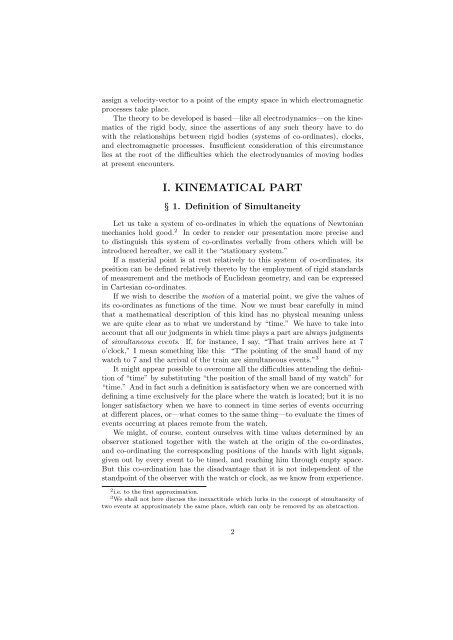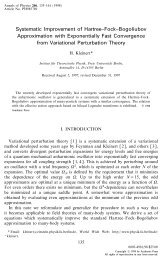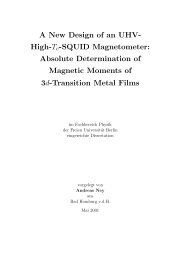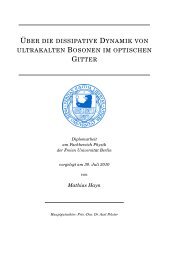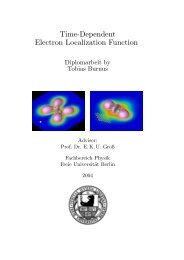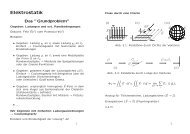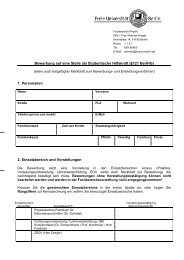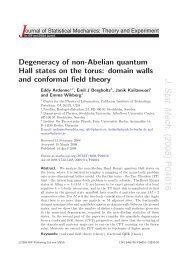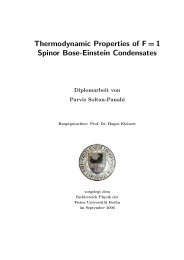Einstein's 1905 paper
Einstein's 1905 paper
Einstein's 1905 paper
Create successful ePaper yourself
Turn your PDF publications into a flip-book with our unique Google optimized e-Paper software.
assign a velocity-vector to a point of the empty space in which electromagnetic<br />
processes take place.<br />
The theory to be developed is based—like all electrodynamics—on the kinematics<br />
of the rigid body, since the assertions of any such theory have to do<br />
with the relationships between rigid bodies (systems of co-ordinates), clocks,<br />
and electromagnetic processes. Insufficient consideration of this circumstance<br />
lies at the root of the difficulties which the electrodynamics of moving bodies<br />
at present encounters.<br />
I. KINEMATICAL PART<br />
§ 1. Definition of Simultaneity<br />
Let us take a system of co-ordinates in which the equations of Newtonian<br />
mechanics hold good. 2 In order to render our presentation more precise and<br />
to distinguish this system of co-ordinates verbally from others which will be<br />
introduced hereafter, we call it the “stationary system.”<br />
If a material point is at rest relatively to this system of co-ordinates, its<br />
position can be defined relatively thereto by the employment of rigid standards<br />
of measurement and the methods of Euclidean geometry, and can be expressed<br />
in Cartesian co-ordinates.<br />
If we wish to describe the motion of a material point, we give the values of<br />
its co-ordinates as functions of the time. Now we must bear carefully in mind<br />
that a mathematical description of this kind has no physical meaning unless<br />
we are quite clear as to what we understand by “time.” We have to take into<br />
account that all our judgments in which time plays a part are always judgments<br />
of simultaneous events. If, for instance, I say, “That train arrives here at 7<br />
o’clock,” I mean something like this: “The pointing of the small hand of my<br />
watch to 7 and the arrival of the train are simultaneous events.” 3<br />
It might appear possible to overcome all the difficulties attending the definition<br />
of “time” by substituting “the position of the small hand of my watch” for<br />
“time.” And in fact such a definition is satisfactory when we are concerned with<br />
defining a time exclusively for the place where the watch is located; but it is no<br />
longer satisfactory when we have to connect in time series of events occurring<br />
at different places, or—what comes to the same thing—to evaluate the times of<br />
events occurring at places remote from the watch.<br />
We might, of course, content ourselves with time values determined by an<br />
observer stationed together with the watch at the origin of the co-ordinates,<br />
and co-ordinating the corresponding positions of the hands with light signals,<br />
given out by every event to be timed, and reaching him through empty space.<br />
But this co-ordination has the disadvantage that it is not independent of the<br />
standpoint of the observer with the watch or clock, as we know from experience.<br />
2 i.e. to the first approximation.<br />
3 We shall not here discuss the inexactitude which lurks in the concept of simultaneity of<br />
two events at approximately the same place, which can only be removed by an abstraction.<br />
2


